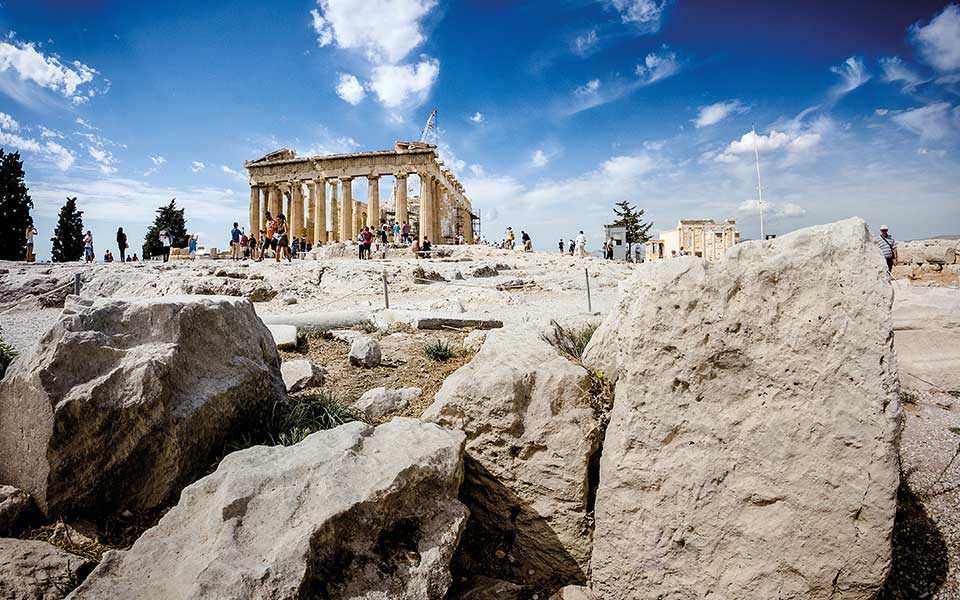Island Goddesses
No doubt about it. Greece is marble. From time immemorial, marble has been a ubiquitous material in the Greek lands, a vibrant, glowing stone first exploited in prehistoric sculpture in the Late Neolithic era (5300-4500 BC), but most visibly in the third millennium BC during the Aegean Early Bronze Age. The single most iconic product of prehistoric Cycladic culture, especially at its peak in the Early Cycladic II period (2800-2300 BC), were white marble figurines of women, possibly fertility goddesses, standing with their arms folded and heads tilted slightly back.
The simple, natural beauty and almost transparent quality of the marble used for Cycladic figurines has long intrigued viewers but, as we now know, for both this and later periods, the white stone was essentially a blank canvas that sculptors, in the final stage of their work, often enhanced with brightly colored paints. Modern laboratory analyses have shown traces of prehistoric color preserved not only on the marble figurines, but on marble and clay vessels as well, and even on bone tools, too.
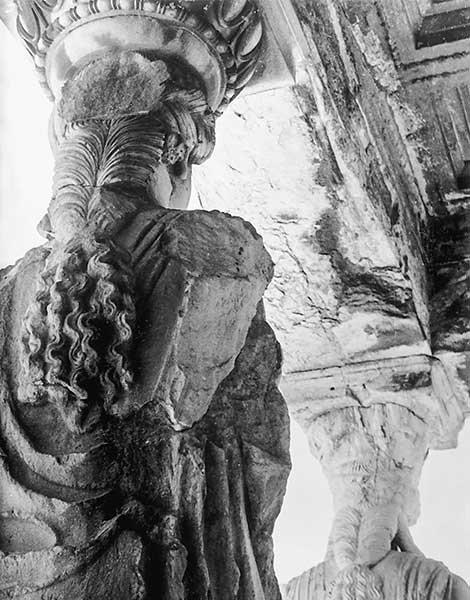
© Nellys/Getty Images/Ideal Image
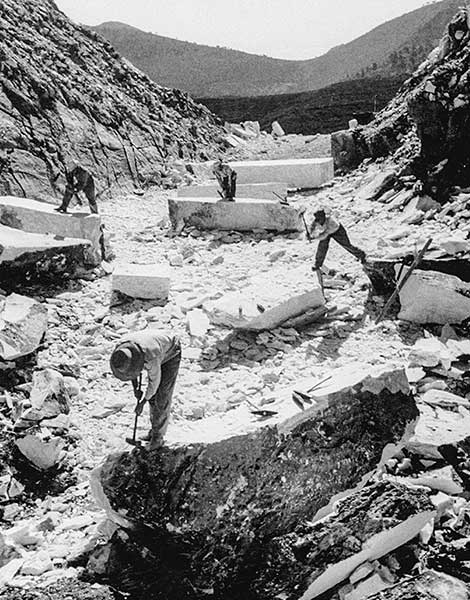
© David Lees/Getty Images/Ideal Image
Rival Producers
Marble quarries in the Bronze Age were found on many Aegean islands, but modern studies have also shown the main sources were Naxos, Keros, Paros and Ios. With the advent of the Archaic era (ca. 800 BC), marble-working again became a major artistic industry.
On Delos, the struggle between Naxos and Paros for hegemony over the sacred island resulted in the Naxians erecting monumental dedications to Apollo, crafted from their local stone, including their imposing Lions (late 7th c. BC), Colossos (late 7th/early 6th c. BC) and Oikos (575 BC), a building described by archaeologist Konstantinos Tsakos as “the first in the history of architecture in which the upper structure and roof were of marble.”
Paros ultimately prevailed, however, at least in the race for marble supremacy, as its white homogeneous marble was of superior quality and easy to carve. Parian marble became the premier material sought after by sculptors across the Aegean and mainland Greece. Quarried underground in long shafts, where slaves worked by lamplight, the stone became known as “Lychnitis,” from the word “lychnos” or lamp. The island’s enormous Quarry of the Nymphs, according to architect Manolis Korres, must have produced nearly 100,000 cubic meters of usable marble.
At Delphi, in the 6th and early 5th centuries BC, Parian marble was used for the Treasury of the Siphnians and the façades of the second Temple of Apollo and the Treasury of the Athenians. Not to be overlooked, the Naxians erected a white marble sphinx (550 BC) on a tall column just below the Temple of Apollo, where ascending visitors saw it first, gleaming in the foreground.

© Panayiotis Tzamaros
Attic Marbles
Attica also produced great quantities of marble in antiquity, with the Classical sanctuary of Athena on the Athenian Acropolis, famously renovated by Pericles in the 5th century BC, providing a magnificent showcase for the extraordinary stone of Mt Penteli.
The first use of Pentelic marble on the Acropolis was in the Older Parthenon, begun just after the Greek victory over the Persians at Marathon (490 BC). This temple of Athena was still unfinished when the Persians invaded Athens in 480 BC and desecrated the Acropolis. With the launch of Pericles’ building program in the 440s BC, Pentelic marble became the primary material of the Acropolis’ new buildings, as well as of buildings in the surrounding area and of many sculpted votive offerings and other statues.
Pentelic marble first appeared in sculpture about 570 BC, while marble of lesser quality from Mt Ymittos was employed in the Archaic era for inscribed steles on the Acropolis. Quarries at Agrileza in southern Attica produced a soft, crumbly marble, which was nevertheless exploited for the Temple of Poseidon at Sounio (444-440 BC). Numerous marble male “Kouros” statues have been found in Attica, but not all were carved from local stone. The marble of the Sounion Kouros (ca. 600 BC) reveals it was an artwork imported from Naxos.
Periclean Perfection
The sheer amount of Pentelic marble required to construct the Periclean Parthenon is breathtaking. Although the foundations are limestone, the entire original superstructure was marble, including the stepped crepidoma (base); 108 exterior and interior columns; 444 coffered ceiling panels; 92 sculpted metopes; the 160 m-long Ionic frieze; the cella’s walls; the pediments, cornices, architraves and beams; the pedimental sculptures and roof-top akroteria; and 9,000 marble roof tiles. Today’s restoration works on the Parthenon also rely on marble from Mt Penteli, nearly identical to the original material, which is extricated from an area behind the prominent peak, whose ancient quarrying scars can still be clearly seen.
Around the Acropolis, the Temple of Hephaestus (begun 445 BC) in the Athenian Agora was also built of Pentelic marble, although its cornice, ceiling, sculpted frieze and other carved architectural elements were rendered in Parian marble. Opposite, the Stoa of Attalos (2nd c. BC), in its currently restored state, contains both Pentelic marble and limestone. The Lysicrates Monument (335/334 BC) in Plaka is pure Pentelic marble.
“‘Marble‘ evoked brilliance and artistic perfection, and became a stock epithet for the most exquisite items of ancient culture. To call something marmoreus was not to describe a raw lump of rock, but a shaped, crafted, polished work of art.” Mark Bradley (2013)
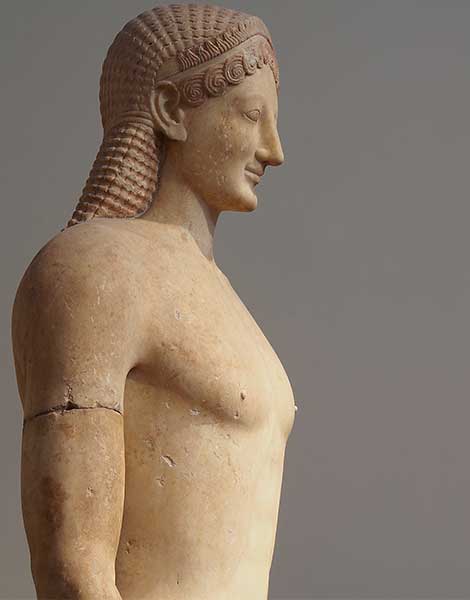
© Dimitris Tsoumplekas
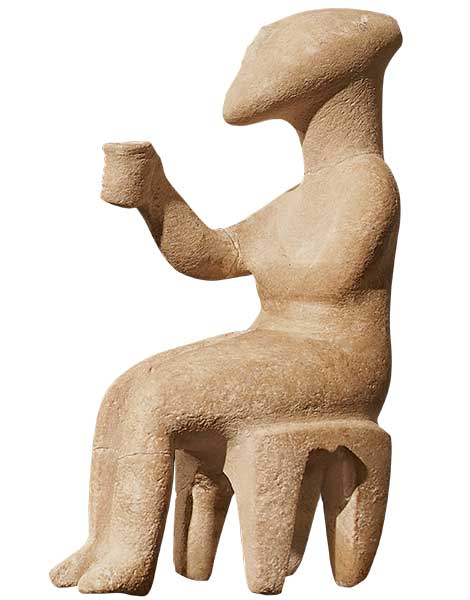
© Dimitris Tsoumplekas
Timeless Labor of Love
The perfection of ancient marble buildings, most notably the Parthenon, is something we can only wonder at nowadays as, even with modern power tools and space-age methods, we’re just beginning to replicate the extraordinary precision and speed of the ancient masons. Using hand tools, including a variety of iron chisels, sharp-tipped points, saws, hammers, wooden and iron wedges, squares, compasses and graduated measuring bars, they achieved final products with margins of error amounting to only a few millimeters. These craftsmen took enormous pride in their work and considered their efforts a gift to Athena or the other gods.
Master marble masons were highly experienced in selecting the best marble to carve, as the material can have cracks, weaknesses and other hidden flaws. Then, aided by other workers, they had to extract the stone from mountain quarries and transport it to the worksite, using ropes and wooden winches, cranes, sledges, carts and rollers.
Rough shaping might take place at the quarry, but final finishing was done on site, including the carving of a column’s delicate flutes after its final placement. Today’s restoration masons follow age-old techniques but are trained somewhat differently. For example, while a contemporary craftsman might “plow” marble in straight lines with his chisel, the marks visible on ancient stones reveal his classical forerunners often sat on a block and chiseled around themselves in circular, zigzag patterns.
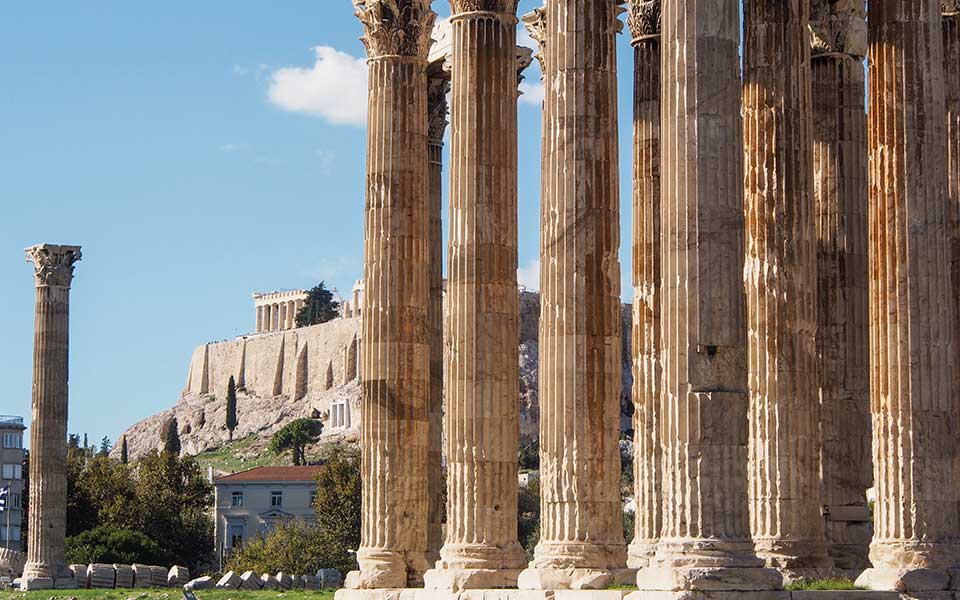
© Dimitris Tsoumplekas
Roman Luxury
Roman rule in Greece witnessed a resurgence in the use of Pentelic marble, as Julius Caesar and Octavian (Augustus) employed it in Athens for the “archaizing” gateway of their new Roman Agora (1st c. BC). In the 2nd century AD, the enormous Temple of Olympian Zeus was completed and an elegant city gate erected by the philhellene emperor Hadrian, while the Panathenaic Stadium (Kallimarmaro) was entirely veneered by Herodes Atticus – a project reported by Pausanias to have nearly exhausted Penteli’s supply of marble.
The Romans were not merely satisfied with white marble, however. At the start of the empire, discovering the spectrum of polychrome marbles that could be acquired around the eastern Mediterranean, they began to import green and red marble from the Peloponnese, grey marble from Evia and black marble from Chios. Green marble also came from Skyros and Tinos, while Thasos provided a fine white marble that could rival Pentelic.
The marble industry also thrived on Mt Ymittos, where quarries produced a grey or bluish-grey stone much beloved by the Romans. A cave on Ymittos above Vari contains a carved relief of a quarryman (“Archedemos”) holding a hammer and square (ca. 400 BC); the mysterious marble “dragon houses” above Kaisariani may have been accommodations for ancient quarry workers.
Marble Traditions
Today, traditional marble working is carried on primarily by craftsmen trained on the island of Tinos. Tinian masons were employed in the reconstruction of the Stoa of Attalos (1950s), and their sons ascended the Acropolis in the mid-1970s to begin work on the Erechtheion. Now, notes Acropolis Restoration Service (YSMA) architect Lena Lambrinou, a third generation of these craftsmen are engaged in the works on the Parthenon.
A long-held Tinian legend claims the island’s inhabitants were originally taught the art of sculpture by Phidias himself, whose ship, en route to Delos, was forced by strong winds to shelter at Tinos. Whether this story is true or not, the Tinians did play a role in the development of modern Athens, where today one finds many modern grand marble edifices, including the Academy of Athens, the Athens Concert Hall and the National Library. Many Athenian apartments built in the 1960s and 70s have traditional marble kitchen sinks, and even many curbs lining the streets are marble.
As we said at the start, Greece is marble!

